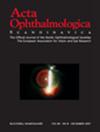Prevalence and associations of dome-shaped maculas. The Beijing Eye Study
Abstract
Purpose
To explore the prevalence and associated factors of a dome-shaped macula (DSM) in a general population.
Methods
Out of the population-based Beijing Eye Study cohort (n = 3468 participants), the investigation included all eyes with an axial length of ≥25 mm, and a randomized sample of eyes with an axial length of <25 mm. Using optical coherence tomographic (OCT) images, we examined presence and height of DSMs, defined as an inward convexity of the foveal retinal pigment epithelium (RPE)/Bruch's membrane (BM) line, detectable in at least two OCT scans perpendicularly orientated to each other.
Results
The study cohort consisted of 366 eyes (314 individuals) with a mean age of 63.7 ± 9.7 years and a mean axial length of 24.8 ± 2.1 mm (median: 25.1 mm; range: 18.96–30.88 mm). Prevalence of DSMs (found in 6/366 eyes; 1.9%; 95%CI: 1.0, 3.0) increased from 0/125 (0%) in non-myopic eyes to 1/152 (0.7%; 95%CI: 0.0, 2.0) in moderately myopic eyes, and to 6/83 (7.2%; 95%CI: 1.7, 12.7) in the highly myopic group. In multivariable analysis, higher DSM prevalence corelated with longer axial length (OR: 2.05; 95%CI: 1.36, 3.08; p < 0.001) and higher stage of myopic macular degeneration (OR: 1.08; 95%CI: 1.01, 1.16; p = 0.03). The mean maximal DSM height was 139 ± 107 μm (median: 100 μm; range: 25–350 μm). It was associated with higher stage of myopic macular degeneration (beta: 0.24; p < 0.001) and higher prevalence of macular BM defects (beta: 0.17; p < 0.001). None of the DSMs showed a serous retinal detachment or relative choroidal thickening.
Conclusions
Higher DSM prevalence correlated non-linearly with longer axial length, with DSM height increasing with the presence of a BM defect. DSMs may be associated with an axial elongation-related BM overproduction in the fundus midperiphery in all meridians.

 求助内容:
求助内容: 应助结果提醒方式:
应助结果提醒方式:


